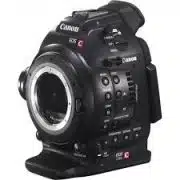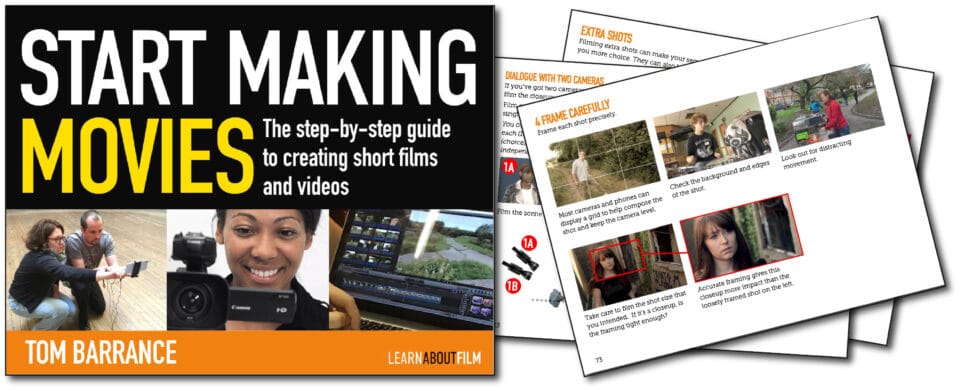Why A Cinema Camera Over A Dslr?
- SLRs and mirrorless cameras are great for the 'flick look'
- Camcorders are easier to employ, and ameliorate for news and events
- Cinema cameras combine the best features of both
Should you lot become a camcorder, a DSLR, a mirrorless camera – or something else – for low budget filmmaking? The option isn't a clear-cutting as it was a few years ago: DSLRs are getting ameliorate, and y'all tin can now get camcorders with DSLR-like features.
What'southward the difference?

A camcorder is designed specifically for shooting video. Nearly of them have built-in zoom lenses and tilt-and-swivel screens. More expensive pro camcorders accept practiced born microphones and professional XLR audio inputs. They aren't slap-up for still photography.

A DSLR (digital SLR) is mainly designed for nevertheless photography. Information technology takes interchangeable lenses. A mirror reflects the prototype up to the viewfinder, and flips up – blacking out the eyepiece – when you take a photo. So when yous shoot video with it, you lot have to use 'Alive View' on the main screen instead.

A mirrorless camera is like an SLR – you lot can swap lenses – simply information technology doesn't have a mirror. Yous view the paradigm on the principal live view screen, or an electronic center-level viewfinder if it has i. They're ordinarily smaller and lighter than DSLRs.
Why would yous shoot video on a camera designed for stills?
Most camcorders accept quite pocket-sized sensors and stock-still zoom lenses. These small sensors aren't great in depression light, which tin can requite SLRs – which have much bigger sensors – a big advantage.
Big sensors also take much shallower depth of field: and then at the aforementioned aperture, less of the shot is in focus. That looks more 'cinematic' (like cinema films rather than video). You can make the nearly of information technology by plumbing equipment broad discontinuity prime (non-zooming) lenses. You can fifty-fifty 'pull focus', irresolute the focus from one part of the image to another as you film.
If DSLR video looks so keen, why doesn't everybody practise information technology?
Cost
DSLRs and mirrorless cameras aren't cheap. You can get a Catechism, Sony or Panasonic Hard disk camcorder for less than $250 (£200); you'll need to spend effectually $400 (£300) for the cheapest new video-capable SLR.
Audio
Many SLRs and mirrorless cameras don't accept headphone sockets, and some can't record good audio even with a dissever microphone. Then you may need to use a separate audio recorder.
Focus
Judging focus on a live view screen can be slow. Y'all may need to magnify the image with a split viewfinder or 'loupe'.
If you're trying to hold focus on moving subjects, shallow depth of field tin exist a nuisance rather than an advantage. SLRs usually take nifty, fast autofocus for stills, just 'alive view' autofocus – with the mirror up – can be much slower.
Treatment and stabilisation
These cameras can be bad-mannered to concur steadily and to motility smoothly for video shots. You may demand a tripod, a monopod, or a special rig. About camcorders have good image stabilisation and so they're easier to apply handheld.
Image quality
SLR sensors are designed to shoot high-resolution stills. Most current ones have at least 18 megapixels, but yous just need two for HD video. Then some cameras, such every bit lower-priced or older Canons, only tape video from some rows of pixels (line-skipping). This can cause distracting interference patterns called moiré or aliasing.
Near SLR video isn't recorded from the whole sensor at once: instead, it scans downward the sensor. This tin can cause 'rolling shutter' baloney when you move the camera sideways or employ it handheld.
Size and complexity
SLRs – and to a lesser extent mirrorless cameras – are bigger than equivalent camcorders, and y'all usually need accessories to become skillful results. But with camcorders, you lot can only selection them upward and commencement shooting. Many have such good prototype stabilisation that y'all don't really need a tripod.
It's getting better
SLR and mirrorless makers – peculiarly Panasonic – accept started taking video equally a serious feature rather than just an improver. Panasonic'due southGH5 mirrorless camera has a whole raft of pro video features including an optional XLR sound module. The much more than affordable Panasonic G85/G80 has excellent prototype stabilisation, and the Canon 80D and mirrorless EOS-M5 have fast video autofocus. On the camcorder front, Canon'sXC15 looks similar an SLR only shoots circulate quality video.
Who should employ SLRs?
I use SLRs, mirrorless cameras, camcorders and an iPhone. I honey the shallow focus and the smashing quality images I can go from the SLR, but when I'k shooting events I detect a semi-professional camcorder much easier and quicker to use. (Frequently, I'll put the camcorder on a tripod for a 'main shot' and apply the SLR for closeups.)
SLRs and mirrorless cameras are all-time if yous're interested in getting that movie-like prototype quality. And then I recommend them for pic students and ultra low-budget filmmakers. And they are definitely the ones to go if you lot want to shoot loftier-quality stills equally well every bit video.
For events and news, good camcorders are improve. Audio is easier and they're easier to pick up and start shooting. And past the time you've stopped downwardly the lens on an SLR to give you enough depth of field for a fast-moving scene, there sometimes isn't that much deviation in low light performance. Some pro and semi-pro camcorders like the Canon XC10 have large one-inch sensors, which are skillful for low-light shooting and give scope for some inventiveness with depth of field.
What else could I use?

If y'all're on a really tight upkeep, you could pimp your phone: a electric currentiPhone with a good filming app, an add-on microphone and a case or pistol grip tin can shoot adept video and attracts less attending than bigger cameras. iPhones are popular with mobile journalists and documentary makers.

Some other portable selection is the DJI Osmo Pocket, a tiny stabilised 4K camera which uses your smartphone every bit the monitor.
Best of both worlds?

If y'all want to combine the advantages of camcorders and SLRs, Canon's professionalMovie theater EOS cameras like the C100 have large Super 35mm sensors and accept interchangeable lenses, just they're much faster to use for filmmaking and have better video and sound quality. Y'all tin can option up a used C100 for a similar toll to a high-end mirrorless camera.

If you desire to record in high quality professional formats that are piece of cake to colour correct and 'form', BlackMagic's Movie theater Cameras are practiced value. ThePocket Movie theater Camera 4K can record RAW and ProRes 4K files at up to 60fps.
Buying guides
DSLRs and mirrorless cameras
Consumer camcorders
Prosumer camcorders
Professional camcorders
Movie theatre cameras
Cameras for filmmaking nether $300/£250
Source: https://www.learnaboutfilm.com/making-a-film/equipment-for-low-budget-filmmaking/camcorder-vs-dslr-vs-mirrorless-2016/
Posted by: wallacesweves.blogspot.com





0 Response to "Why A Cinema Camera Over A Dslr?"
Post a Comment